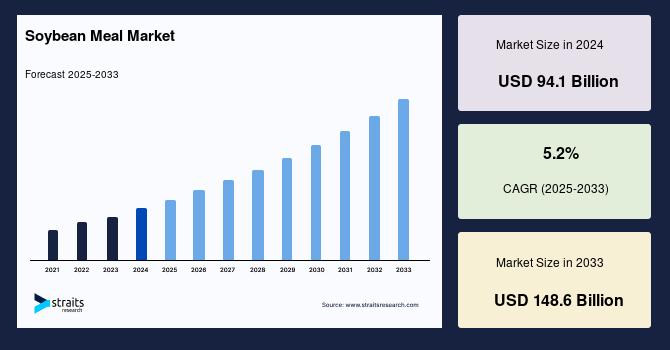Soybean Meal Market Outlook 2025-2033: Expanding Demand in Animal Nutrition and Sustainability

The global soybean meal market was valued at USD 94.1 billion in 2024 and is projected to grow from USD 98.7 billion in 2025 to USD 148.6 billion by 2033, registering a CAGR of 5.2% during the forecast period (2025–2033).
Key Drivers of Market Growth
Soybean meal is a preferred protein source in animal feed due to its rich amino acid profile, digestibility, and cost-effectiveness. The expanding global consumption of meat, dairy, and eggs, especially across Asia-Pacific, Latin America, and emerging economies, is fueling higher demand for high-quality feed ingredients. Government-supported initiatives to modernize livestock farming and improve feed efficiency are further boosting soybean meal adoption.
Concerns over feed safety, traceability, and environmental impact are shaping purchasing decisions in feed supply chains. As buyers increasingly require verified sustainable sourcing, third-party certifications and compliance with global emissions reporting frameworks have become essential. Manufacturers are responding by developing enhanced soybean meal product variants such as enzyme-treated and low-oligosaccharide options to improve nutrient absorption and support optimal animal growth.
Supply Challenges and Opportunities
The soybean meal market is closely linked to the raw soybean commodity, meaning fluctuations in soybean production and prices directly impact meal availability and cost. Extreme weather events, including severe droughts in Brazil and flooding in parts of the United States, have disrupted soybean harvests and export schedules in recent years, causing supply inconsistencies and price volatility.
Geopolitical tensions among major soybean exporters like Argentina and Brazil also strain trade flows. These combined factors pose challenges for feed producers who operate under tight margins and demand stable input costs for long-term contracts.
The European Union’s new anti-deforestation regulatory framework presents both challenges and opportunities, especially for aquaculture feed suppliers targeting sustainability-conscious markets in the Western Mediterranean. Sourcing soy compliant with these regulations boosts market access and aligns with growing global environmental commitments.
Regional Market Landscape
Asia-Pacific leads the global soybean meal market thanks to strong growth in poultry, aquaculture, and livestock sectors. Increasing per capita meat consumption, investments in feed manufacturing infrastructure, and the modernization of agricultural supply chains are driving consistent demand. Public-private collaborations and expanding regional trade routes accelerate market development throughout key countries in the region.
North America maintains a significant market share due to its integrated production and distribution ecosystem. With advanced oilseed processing capabilities and a mature animal farming industry, the region ensures steady consumption of soybean meal across poultry, swine, and cattle sectors. North America's role as a key soybean and meal supplier during global supply disruptions underscores its influence in the market. Emphasis on feed quality, safety standards, and transparency further supports the region’s leadership.
Latin America is a vital production and export hub, benefiting from favorable climate, vast arable land, and numerous commercial-scale oilseed processors. The region's export-oriented supply chains link directly with global buyers, while infrastructure investments and government policies help navigate logistics and economic challenges. Latin America’s commitment to meeting international sustainability and traceability standards enhances its market positioning among health- and environment-conscious consumers.
Product Segments and Applications
Conventional soybean meal dominates the product category due to its wide availability and high protein content. Produced mainly via solvent extraction, this meal type is favored for commercial-scale feed formulations given its consistent amino acid profile and versatility in various animal diets.
The animal feed sector accounts for the largest share of consumption, with soybean meal serving as a critical protein source supporting muscle development, growth efficiency, and reproductive health, particularly in poultry and pig farming. The ongoing rise in global meat consumption, especially in Asia and Africa, ensures continued feed demand growth.
Genetically modified (GM) soybean meal holds the largest market share in feed applications since GM soybean cultivation is widespread in major producing countries. GM soy offers agronomic benefits like higher yields and pest resistance, improving overall supply stability and reducing production costs. Nutritionally, GM and non-GM meals are equivalent, but GM meal’s pricing advantage and scalability make it the preferred choice in many markets.
Distribution and Procurement Trends
Bulk direct procurement remains the dominant distribution channel, particularly for large feed manufacturers and vertically integrated livestock and poultry operations. Direct sourcing from crushers and commodity traders ensures volume consistency and favorable pricing. Increasingly, digital procurement platforms and online agri-marketplaces are enhancing transparency and logistics efficiency for mid-sized buyers seeking contract flexibility and traceability.
Poultry feed is the largest end-use segment, given the sector’s growing demand for broiler meat and eggs worldwide. Soybean meal’s digestibility and essential lysine content make it a staple in feed formulations to promote predictable growth and production cycles. Leading poultry integrators standardize feed to incorporate soybean meal as a protein base, ensuring nutritional reliability.
Competitive Landscape and Industry Outlook
The soybean meal market is moderately consolidated, with large agribusiness and processing giants commanding significant shares of production and international trade. These companies leverage integrated crushing capacities, long-term logistics agreements, and extensive infrastructure to serve diverse customer bases across regions.
For instance, Bunge Global SA stands out as a key global player with operations in over 40 countries. The company’s investments in renewable feedstock and recent mergers reflect its strategy to strengthen supply chain resilience and sustainability credentials.
Looking ahead, the soybean meal market is set to continue growing, supported by rising animal protein demand, innovations in feed technology, and increasing alignment with environmental and sustainability standards. Strategic sourcing, product diversification, and digital supply chain advancements will be critical factors shaping market success over the next decade.
- Art
- Causes
- Best Offers
- Crafts
- Dance
- Drinks
- Film
- Fitness
- Food
- Giochi
- Festival
- Gardening
- Health
- Home
- Literature
- Music
- Networking
- Altre informazioni
- Party
- Religion
- Shopping
- Sports
- Theater
- Wellness



